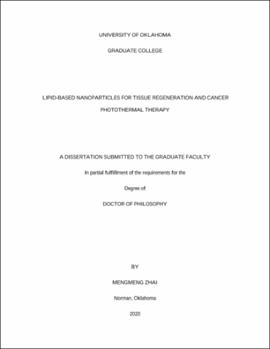| dc.description.abstract | Exosome, a cell budded nanovesicle in diameter around 30 nm to 200 nm, has been found useful for the gene and drug delivery in bone tissue regeneration and cancer therapy. Exosome derived from donor cells has some specific physical properties, such as stability, permeability, low toxicity, lower immune response, and biocompatibility for gene and drug delivery. In this dissertation, stem cell-derived exosomes were used to induce bone tissue regeneration in vitro and in vivo. In addition, exosomes were modified with tumor-homing peptide for target breast cancer therapy.
In chapter 2, this study confirmed that exosomes could be employed to induce osteogenic differentiation of human mesenchymal stem cells (hMSCs) and decorate 3D-printed titanium alloy scaffolds to achieve cell-free bone regeneration on a bone radial defect rat model. Specifically, the exosomes secreted by hMSCs osteogenically pre-differentiated for different periods were applied to induce the osteogenesis of hMSCs. It was discovered that pre-differentiation for 10 and 15 days led to the production of osteogenic exosomes. Then purified exosomes were loaded into the scaffolds and the current researchers found that the cell-free exosome-coated scaffolds regenerated bone tissue as efficiently as the well-reorganized hMSC-seeded exosome-free scaffolds within 12 weeks. RNA-sequencing results suggested that these osteogenic exosomes induced the osteogenic differentiation by using their upregulated osteogenic miRNA cargos (such as Hsa-miR-146a-5p, Hsa-miR-503-5p, Hsa-miR-483-3p, and Hsa-miR-129-5p) or downregulated osteogenic miRNAs cargos (such as Hsa-miR-32-5p, Hsa-miR-133a-3p, and Hsa-miR-204-5p) to activate the PI3K/Akt and MAPK signaling pathways. Consequently, identification of osteogenic exosomes secreted by pre-differentiated stem cells and the use of them to replace stem cells represent a novel cell-free bone regeneration strategy.
In Chapter 3, phage display and nanotechnology were integrated to develop novel exosome-based nanoparticles for delivering platinum nanoparticles (PtNPs), a photothermal reagent, for targeted breast cancer therapy. An exosome-internalizing peptide was first identified through a phage display technique. Then a novel nano complex (defined as the EAPW- nano complex) was developed by loading the peptide modified PtNPs into exosomes, of which the surface has been engineered to display breast cancer tumor-homing peptides. The tumor-homing peptides on exosomes led to enhanced delivery of PtNPs to the breast cancer cells in vitro and the tumors in vivo, resulting in significantly improved cancer-killing efficiency and inhibition of tumor growth. | en_US |
